

Seattle City Council. Seattle City Council's Zero Waste priorities for 2010-2011 In 2010-2011, the Seattle City Council will continue to pursue the strategies outlined in the Zero Waste Strategy, Resolution 30990 to achieve our goal of recycling 60 percent of waste produced in the City of Seattle by 2012 and 70 percent by 2025.

These next steps includes efforts to bring organics service to multi-family homes, and remove phone books, disposable plastic bags from the waste stream. Organics service multi-family buildings: In 2009, Seattle Public Utilities began providing its single family residential and some business customers with an organics service to remove food waste from landfills. Council will explore ways to expand the service to include multi-family housing. This will be considered in 2010, for implementation in 2011.
King County. Zero Waste of Resources is an idea that is catching on throughout the country.

King County adopted a policy to work toward Zero Waste by 2030, meaning that materials of value, whether for reuse, resale, or recycling, won't be put in the garbage and end up in the landfill. Studies done at the Cedar Hills Regional Landfill show that 75% of the "stuff" we throw away each year isn't really waste. The majority of these items could be recycled, composted, or reused. Washington State's Beyond Waste Plan. Beyond Waste is the Washington state plan for managing hazardous and solid waste.
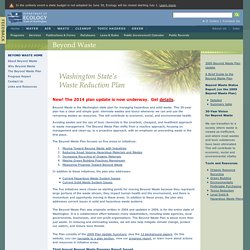
This 30-year plan has a clear and simple goal: eliminate wastes and toxics whenever we can and use the remaining wastes as resources. This will contribute to economic, social, and environmental health. Governnor's Executive Order. Green Chemistry Curriculum. Green Chemistry: The Green Curriculum "Benign by design," green chemistry is designed to have less impact on the environment by creating lower levels of waste and toxicity than traditional chemistry.
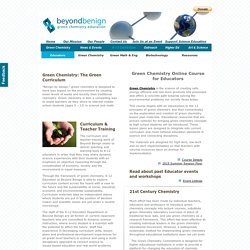
Green chemistry is also a compelling way to assist teachers as they strive to interest middle school students (ages 9 – 13) in science and math. Curriculum & Teacher Training. Washington Green Schools. By improving recycling and waste management systems, schools can reduce fiscal and environmental costs associated with excessive or improper waste disposal.
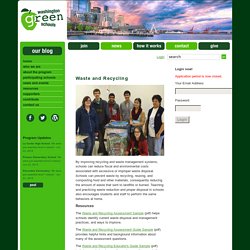
Waste Reduction and Recycling. Waste reduction and recycling are the focus of Level One of the King County Green Schools Program.
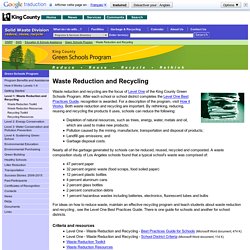
After each school or school district completes the Level One Best Practices Guide, recognition is awarded. For a description of the program, visit How it Works. A Roadmap for Green Chemistry. Zero Waste Alliance. GrassRoots Recycling Network. Sustainable Bainbridge. Zero Waste Seattle. About Us — Washington Toxics Coalition. Info Washington Toxics Coalition uses groundbreaking research, top-notch advocacy, in-depth grassroots organizing, and high-quality consumer information to help create a healthier and just world by promoting safer products, chemicals, and practices, and a healthier future for the next generation.
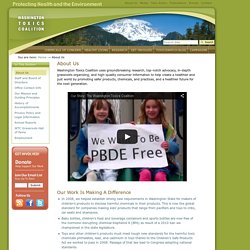
In 2008, we helped establish strong new requirements in Washington State for makers of children’s products to disclose harmful chemicals in their products. This is now the global standard for companies making kids’ products that range from pacifiers and toys to cribs, car seats and shampoos. Baby bottles, children’s food and beverage containers and sports bottles are now free of the hormone-disrupting chemical bisphenol A (BPA) as result of a 2010 ban we championed in the state legislature.
2010 Sustainability Report. Interface Sustainability. A New Materials Economy. The production, processing, and disposal of materials in our modern throwaway economy wastes not only materials but energy as well.
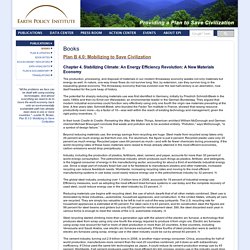
In nature, one-way linear flows do not survive long. Nor, by extension, can they survive long in the expanding global economy. The throwaway economy that has evolved over the last half-century is an aberration, now itself headed for the junk heap of history. The potential for sharply reducing materials use was first identified in Germany, initially by Friedrich Schmidt-Bleek in the early 1990s and then by Ernst von Weizsäcker, an environmental leader in the German Bundestag. They argued that modern industrial economies could function very effectively using only one fourth the virgin raw materials prevailing at the time.
In their book Cradle to Cradle: Remaking the Way We Make Things, American architect William McDonough and German chemist Michael Braungart conclude that waste and pollution are to be avoided entirely. Remanufacturing is even more efficient.
Managing and Reducing Waste. A-Way With Waste Resources. GreenDisk. Living Building Challenge. The Living Building Challenge™ is a building certification program, advocacy tool and philosophy that defines the most advanced measure of sustainability in the built environment possible today and acts to rapidly diminish the gap between current limits and the end-game positive solutions we seek.

The Challenge is comprised of seven performance categories called Petals: Place, Water, Energy, Health & Happiness, Materials, Equity and Beauty. Petals are subdivided into a total of twenty Imperatives, each of which focuses on a specific sphere of influence. This compilation of Imperatives can be applied to almost every conceivable building project, of any scale and any location—be it a new building or an existing structure. Download the Living Building Challenge 3.0 Standard document below. For more information, Download the Living Building Challenge Standard 3.0 (PDF) Learn about prior versions of the Standard. Green Chemistry. HWTR > Pollution Prevention > Green Chemistry at Ecology What is green chemistry?
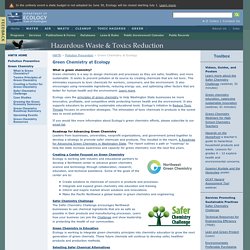
Green chemistry is a way to design chemicals and processes so they are safer, healthier, and more sustainable. It seeks to prevent pollution at its source by creating chemicals that are not toxic. This eliminates exposure to toxic chemicals for workers, consumers, and the environment. Green Chemistry. The Road to a Carbon Neutral Seattle by Richard Conlin. Richard Conlin is president of Seattle's City Council, which is overseeing the city's effort to become the first carbon neutral city in the United States.
He blogs about what reaching that goal really means for YES! Magazine. A key strategy that contributes to Seattle's carbon neutrality work was approved by the Council in 2007, when my Zero Waste Initiative was adopted as City policy. The things we throw away not only generate carbon as they decompose—they also carry the embedded carbon that was used in creating them. Zero Waste is a strategy that addresses both of those aspects. In the 1980s, Seattle embraced a commitment to recycling a minimum of 60 percent of our solid waste. That meant that we would continue to consume resources at an expanding rate. The Zero Waste Strategy set a new goal: Strive to reduce our waste stream to the minimum possible by making cradle-to-cradle responsibility the cornerstone for how we treat products.
The Majestic Plastic Bag - A Mockumentary. Zero Waste - Sustainability Ambassadors.